In the south of the territory of Siena, the Val d’Orcia is a famous tourist destination in Tuscany, with its landscapes of postcards emblematic of the region. Its harmonious countryside has long been domesticated by man, formed of gentle hills, covered with undulating fields, whose colors change with the seasons, from the green of fresh grass in spring to the gray of winter, through the golden autumn. Its typical dirt roads, lined with cypresses, lead to isolated farms often located on small heights.
This country is famous for its charcuterie (from Cinta Senese pig), its sheep cheeses from Pienza (like Pecorino), and its excellent wine (Brunello di Montalcino).
It is for this agricultural heritage that the territory of Val d’Orcia has been declared a UNESCO World Heritage Site, but also because of its charming historical and artistic villages. Among these, the «ideal city» of Pienza, invented in the fifteenth century, is itself listed at UNESCO. Other beautiful villages are for example San Quirico d’Orcia an ancient pilgrimage stop, Castiglione d’Orcia and its fortresses, Montalcino and its prestigious wine, Radicofani whose imposing fortress dominates the valley, the wild baths, or Montepulciano in limit of the territory towards the Val di Chiana
Tourism is very developed, particularly in the most emblematic places. Even the cypresses lost in the middle of the fields see visitors stop permanently in good weather.
The car is almost indispensable to enjoy the Val d’Orcia, in order to connect the tourist points taking the panoramic roads, stopping to enjoy the most photogenic landscapes.
Tourist map of the Val d’Orcia
If you see this after your page is loaded completely, leafletJS files are missing.
From Montepulciano to Montalcino
Montepulciano, Val d’Orcia
Perched on a hill, the large Tuscan village of Montepulciano is one of the most charming in the region, at the edge of the Val d’Orcia, overlooking the Val di Chiana. Its fame is due to its wine Nobile di Montepulciano as well as its medieval authenticity. You can walk through its beautiful streets, passing by the suggestive main square Piazza Grande, the ancient palaces, the museum, shops and cellars, or the panoramas on the region.
→ Read also the page on Montepulciano
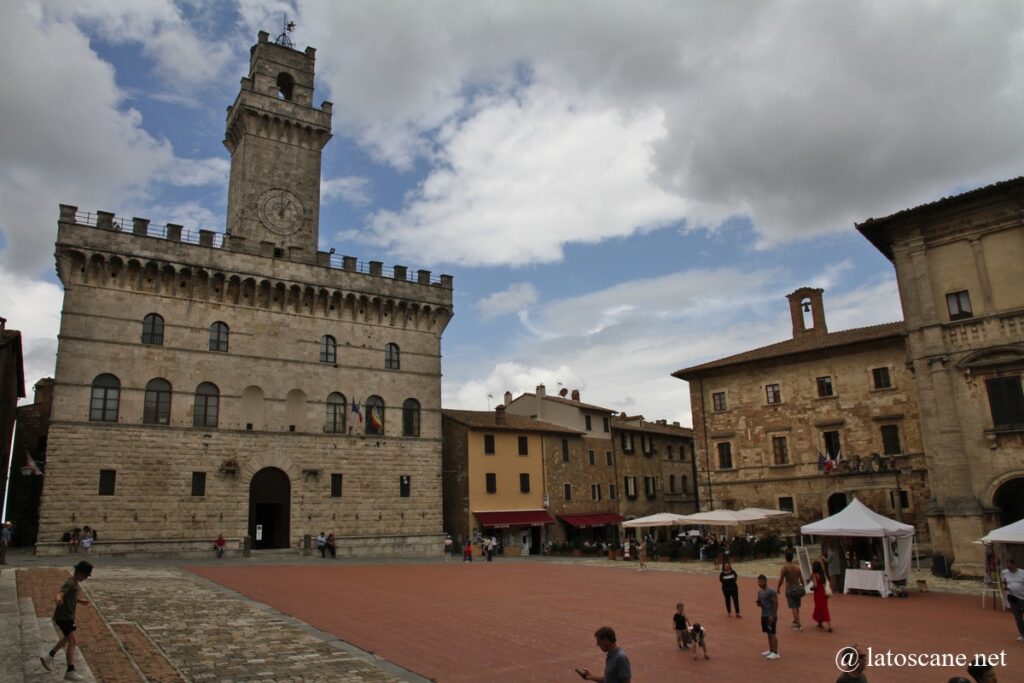
Monticchiello
Monticchiello is a small typical medieval village perched on a hill in the Val d’Orcia between Pienza and Montepulciano.
It’s an authentic piece of medieval, protected by sturdy walls, with its narrow streets and austere fortress that seem to arise from the past, built in the thirteenth century by the Republic of Siena.
Its Torre del Cassero tower is seen in the distance. You enter the town through the Porta Sant’Agata, and you also discover the church Pieve dei Santi Leonardo e Cristoforo with frescoes from the fourteenth and fifteenth centuries.
It is also the summer setting of the “Teatro povero”, a famous theatre that draws inspiration from local and peasant history and life to explore current and societal themes.
Cypress Road of Monticchiello
Near Montichiello, to the south, the “cypress road”, SP 88, is known for one of the most remarkable roads in Tuscany with its curves bordered by cypresses, in the beautiful nature reserve of Lucciola.
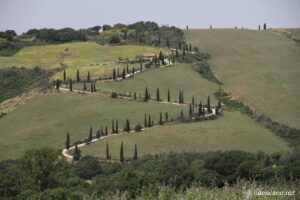
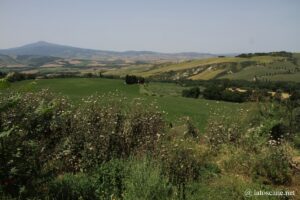
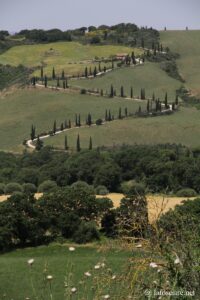
Quercia delle Checche
This monumental oak tree is near Montichiello, south of Pienza. It is almost 400 years old and 22 metres high.
Pienza and surrounding
Pienza is an elegant small town of the Renaissance, created in the fifteenth century by the will of Pope Pius II to transform his native village into a city ideal of the Renaissance. Its main buildings are around the central Piazza Pio II, and a beautiful panoramic walk runs along the ancient ramparts.
It is also known for its pecorino.
Pienza is close to other sites such as the Gladiator’s cypress, the Vitaleta Chapel, etc.
→ Read also the page on Pienza
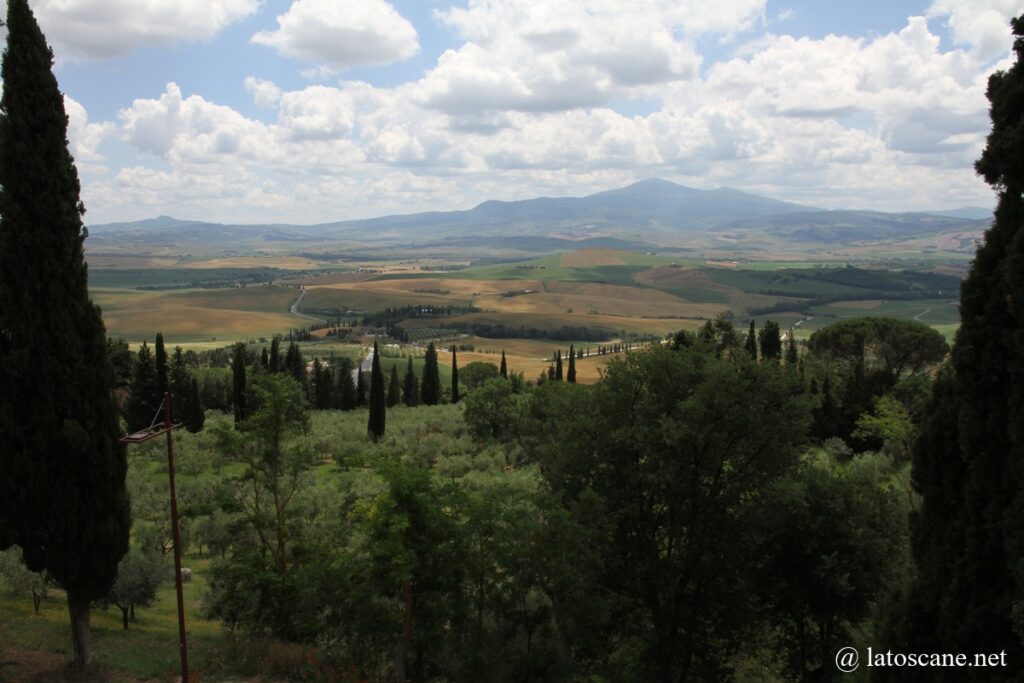
Campi Elisi in Val d’Orcia
The Campi Elisi (Elysium in English) was the location for the final scene of Ridley Scott’s Gladiator on a typical cypress-lined path, near Pienza, which can be easily reached on foot from the priory of Carignano below the village. Very suggestive at sunset.
Chapel of the Madonna di Vitaleta
Between Pienza and San Quirico d’Orcia, this Cappella della Madonna di Vitaleta is one of the most famous places in the region, emblematic of Tuscany, very suggestive with this small chapel at the end of a cypress alley isolated in the middle of fields and a beautiful landscape. We reach it from the parking lot by a kilometer on foot.
Its origin goes back to a statue of the Virgin placed there in 1553 (attributed to Andrea della Robbia) where the Virgin Mary appeared to a shepherdess. This statue is now in the church of the Madonna di Vitaleta in San Quirico.
The current building, which has a basic shape and is made of white stone, dates back to a 19th-century redesign.
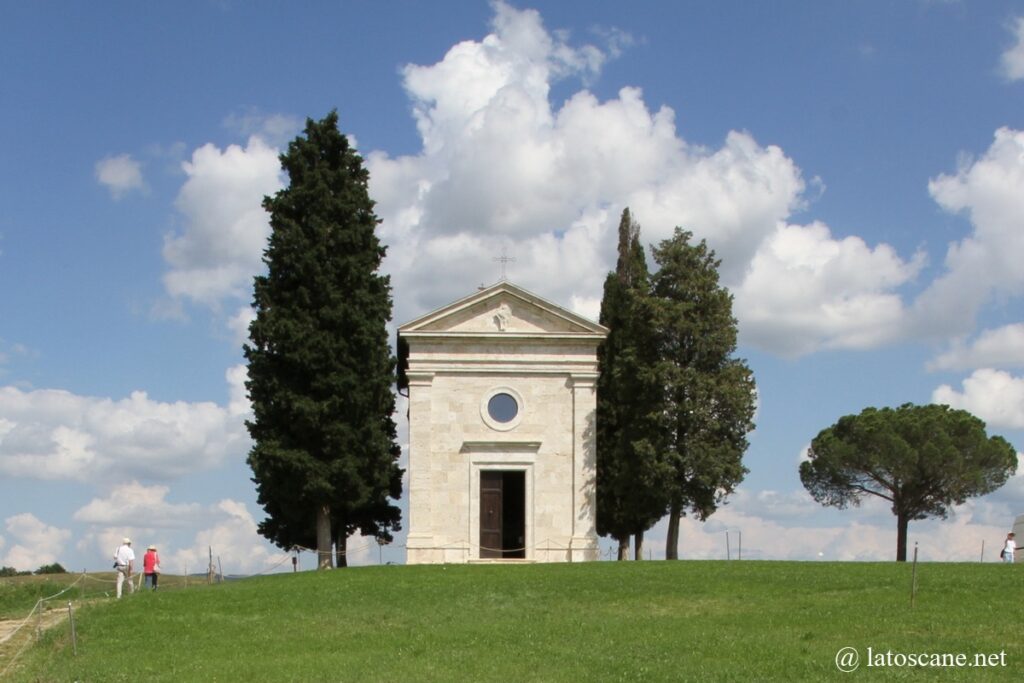
San Quirico d’Orcia – Val d’Orcia
San Quirico is one of the most beautiful villages in Tuscany, long frequented by pilgrims passing through the Via Francigena. It still has beautiful fortifications, the Romanesque collegiate church, old churches, the remains of the castle or the garden of the Leonini Horti.
→ Read also the page on San Quirico
Cypress of San Quirico
About 6 kilometres far from San Quirico d’Orcia, in the place called I Triboli, it is one of the most photographed sites in Tuscany, yet just a grove of cypresses on hilly crops.
Cypress grove in the middle of cultivated hills, in a landscape that changes color with the seasons.
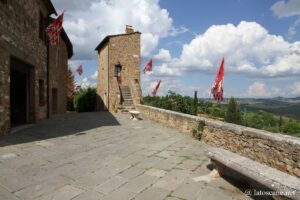
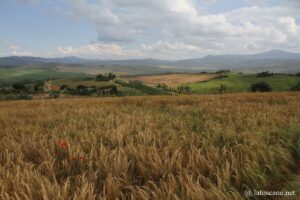
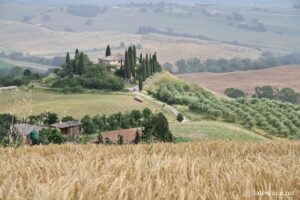
Montalcino in Val d’Orcia
Towards the end of the Val d’Orcia and north of Mount Amiata, Montalcino is famous for its prestigious wine Brunello di Montalcino. Its historic town is also full of charm, beautiful small medieval town built on a hill surrounded by vineyards and woods. It keeps its fortifications, beautiful alleys, stairs, the beautiful municipal palace flanked by a tower, churches and museums.
→ Read also the page on Montalcino
Abbey of Sant’Antimo in Val d’Orcia
Near Montalcino, Sant’Antimo is one of the most beautiful Tuscan abbeys, with a Romanesque style with French and Lombard influences. It is also an old Benedictine convent. From the 12th century, the structure was later modified, with the large church, the remains of a cloister and other remains.
You can reach it by a panoramic road through vineyards and olive groves.
→ Read also the page on the Abbey of Sant’Antimo
Montenero
On the road to the Maremma, Montenero is a small stone village at the top of a rocky outcrop with a beautiful position. Its medieval fortifications date from the Aldobrandeschi, surrounded by olive trees and vineyards.
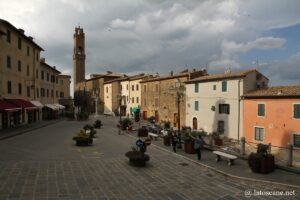
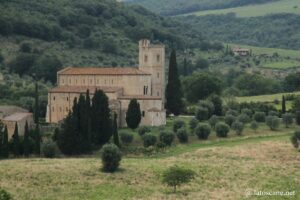
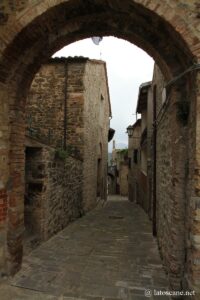
From Castiglione to Radicofani
Bagno Vignoni and Thermal Baths
Located near the Via Francigena, between Castiglione and San Quirico, Bagno Vignoni is a small hamlet watered by the hot thermal waters. These fill a large basin in the Piazza dei Sorgenti.
→ Read also the page on Bagno Vignoni
Spedaletto Castle
The Spedaletto complex was built in the 12th century along the Via Francigena to accommodate pilgrims and travellers, then owned by the hospital of Santa Maria della Scala in Siena. It became a real fortified farm in the fifteenth century with its rectangular enclosure. Near the castle is the church of San Niccolò in Spedaletto.
Today it is a farm and agritourism offering accommodation.
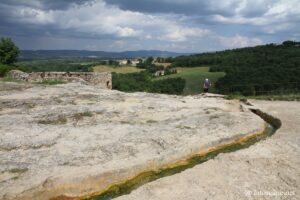
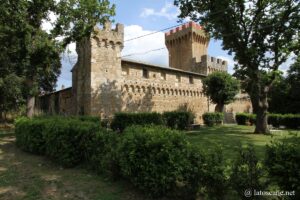
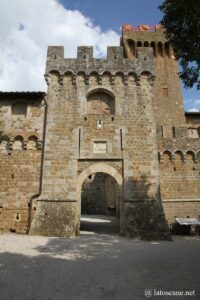
Castiglione d’Orcia and Rocca d’Orcia
Dominated by the remains of its mighty fortress Aldobrandeschi, Castiglione d’Orcia rises proudly from a balcony on the slopes of Mount Amiata open to the valley. It is a beautiful medieval village. Nearby, a rocky peak is crowned by an impregnable medieval keep, the Tentennano Tower, which can be seen from afar in the valley.
→ Read also the page on Castiglione d’Orcia
Viale dei Cipressi of Castiglione d’Orcia
Cypress path from via Cassia, one of the most photographed points in the Val d’Orcia.
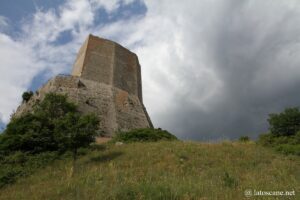
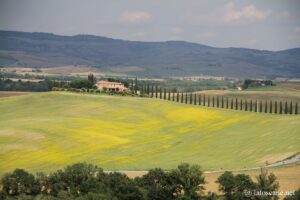
Contignano
Another charming medieval village, in the municipality of Radicofani, with a fortified medieval core, their picturesque alleys leading to a pretty square with its well and a 15th century palace, with the tower. The discreet church of Santa Maria Assunta is also hidden.
Bagni San Filippo
On the eastern slopes of Mount Amiata, Bagni San Filippo is a thermal village known since antiquity for its therapeutic waters. They cross a beautiful wood, feeding beautiful natural limestone pools, free access.
Towards the heights, Vivo d’Orcia preserves at almost 900 meters of altitude a patrimony of ecclesiastical origin, including a church and an hermitage in the middle of the forest dating back to the eleventh century.
→ Read also the page about Bagni San Filippo and Vivo d’Orcia
Radicofani
Radicofani is noticeable from afar thanks to its beautiful medieval fortress, one of the most beautiful in Tuscany, impressing the traveler traveling through the Val d’Orcia. The village also has beautiful remains, very well conversed with Romanesque churches, palaces, or an old post house.
→ Read also the page about Radicofani
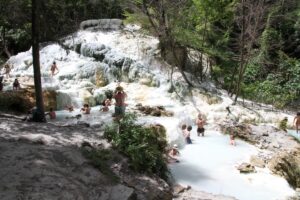
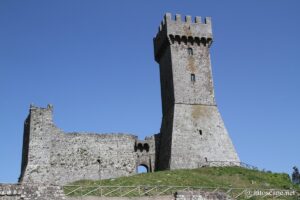
Sarteano surroundings
Castiglioncello del Trinoro
On a terrace in the Val d’Orcia, Castiglioncello del Trioro is a small peaceful stone village that offers a beautiful view of southern Tuscany. Place inspiring great serenity, especially at sunset. On the acropolis there are only a few stones left in the middle of the grassy expanse. There is a good hotel and some beautiful buildings.
Sarteano in Tuscany
Sarteano is a village on the natural border between the Val d’Orcia and the Val di Chiana. It is not the most famous of the tourists, but with a remarkable square castle, and a museum documenting the beautiful Etruscan tombs in the area.
→ Read also the page about Sarteano
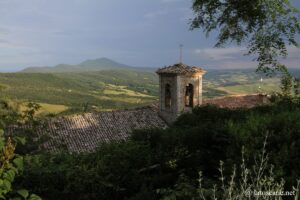
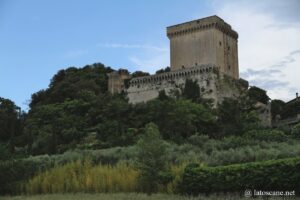
Links and sources
- General informations: en.wikipedia.org
- Tourist portals: visitvaldorcia.it, www.visittuscany.com
No Comments Yet